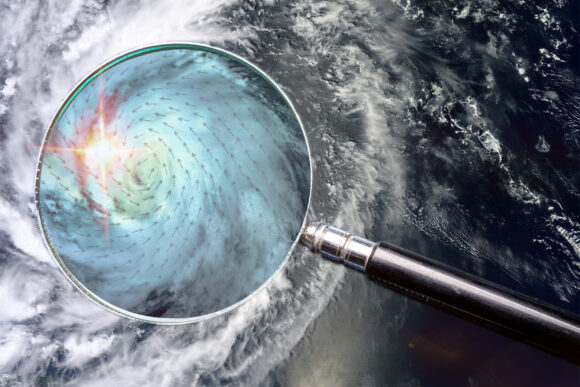Like death and taxes, the annual hurricane season can be counted on as a sure thing. The number and intensity of named storms may vary each year, as well as where they occur and whether or not they make landfall. But there’s no doubt that these storms will develop yearly — it’s a matter of when, not if — and some scientists see increasingly more intense and wetter storms in the future as the climate continues to warm.
A report — Preventing the next Katrina — published by Munich RE in 2020 and written by Mark C. Bove, Meteorologist and Natural Catastrophe Solutions manager, notes that when Hurricane Katrina made landfall in southeast Louisiana in 2005, “the impacts of climate change on tropical cyclones was a subject of intense debate within the meteorological community.” Aside from Katrina, which still stands as the most catastrophic and expensive hurricane in U.S. history, 2005 was a storm-packed year in which the country saw 12 hurricane landfalls within the span of 15 months. At the time, some scientists were attributing elevated intensities of tropical cyclones to climate change. Others argued that the historical record of hurricanes previous to the satellite era was not reliable enough to come to that conclusion.
“Since that time, significant progress has been made in understanding the complex interaction of tropical cyclones and climate,” Munich RE’s report states. A scientific review of the latest climate models “found that precipitation rates of tropical cyclones will increase globally with ongoing climate change, the proportion of Saffir-Simpson category 4-5 storms will increase globally, and the frequency of category 4-5 storms will increase globally, among other possible changes (Knutson et al. 2020).”
According to meteorologists, in a warmer world heavier rainfall can be expected, the report states. The recent experience of residents of southwest Louisiana could be seen as a prime of example of climate-induced higher volumes of rainfall, with or without a tropical cyclone. With the area still struggling to recover from last year’s back-to-back hurricanes Laura and Delta, southwest Louisiana was hit in May with day after day of unrelenting rainfall. According to the Associated Press, 400 to 500 structures in Lake Charles were estimated to have been flooded in just one day.
Munich RE’s report also notes that “tropical cyclones appear to move slower today than in the past, possibly as a result of weakening atmospheric currents in the summer that can be linked to climate change (Kossin 2018). Slower storms or ones that stall, like 2017’s Harvey or 2019’s Dorian in the Bahamas, allow torrential rains, wind, and/or surge conditions to persist over one location for long periods of time, leading to more damage and disruption than if the storm passed though quickly.”
Rising seas, also associated with a warmer climate, exacerbate tropical cyclone generated storm surge, as well. Munich RE’s Katrina report uses as an example Hurricane Donna, which impacted New York City in September 1960. At that time, “surge heights in the inner harbor came within six inches of being able to flood subway tunnels in lower Manhattan. If an exact repeat of Donna [had] occurred in September 2020, its storm surge would occur on top of seven additional inches of sea level, flooding the subway and having a far greater impact on the city and its daily life than it did 60 years ago.”
CoreLogic’s 2021 Hurricane Report examines the potential impact to residential dwellings in the U.S. from hurricane-driven wind and storm surge.
Evaluating storm surge and hurricane wind risk levels for both single-family (SFR) and multifamily (MFR) residences along the Gulf and Atlantic coasts for the 2021 hurricane season, CoreLogic identified more than 31 million single-family homes, and close to one million additional family homes in multi-unit buildings, that were at moderate or greater risk from damaging hurricane winds. Around eight million were found to be directly or indirectly exposed to risk from coastal storm surge.
In terms of recovery, losses and loss adjustment expenses from 2021 coastal storm events may be particularly impacted by the “significant price increases for lumber and other building materials in recent months,” Moody’s Investors Service has pointed out.
Current Projections
The Atlantic hurricane season officially runs from June 1 through November 30, although Tropical Storm Ana jumped the gun when it became a tropical storm on May 23. Ana made 2021 the seventh year in a row in which a named storm formed before the hurricane season started, according to the Insurance Information Institute (I.I.I.).
Moody’s Investors Service notes in its report, Weak La Nina and Warm Waters Point to Active 2021 Atlantic Hurricane Season, that eight weather research organizations have predicted an above-average hurricane season this year. “These forecasts project that tropical storm activity this year will be well above the long-term average of 12 named storms, six hurricanes and three major hurricanes per season experienced between 1950 and 2020,” Moody’s noted. None are projecting a season like 2020 with its record-breaking 30 named storms, 11 of which made landfall in the continental U.S, however.
Early forecasts predict between 14 and 19 named storms in 2021, with seven to 11 possibly developing into hurricanes, and the potential for three to five hurricanes reaching major hurricane status (Category 3, 4 or 5) with wind speeds greater than 111 miles per hour, Moody’s said.
Factors influencing the predictions for 2021 include the current La Nina conditions, which “tend to result in an increase in the number of Atlantic hurricanes that develop and allow more intense hurricanes to form.”
As noted above, Hurricane Katrina, which devastated New Orleans and coastal Mississippi in August 2005, remains the costliest hurricane to make landfall in the U.S. Including losses from the National Flood Insurance Program (NFIP), Katrina racked up $65 billion in insured losses. In terms of 2020 dollars, that amount would inflate to $86.6 billion, according to Aon.
But as Munich RE stated in its report, “Hurricane Katrina was the first natural catastrophe in the 21st century that forced an extended, complete shutdown of a major U.S. city and metropolitan area, and it will probably not be the last.”
Was this article valuable?
Here are more articles you may enjoy.



 Progressive Gains as Drivers Shop Around for Auto Insurance—Again
Progressive Gains as Drivers Shop Around for Auto Insurance—Again  Survey Shows Majority of Florida, California Homeowners Seeing Higher Insurance Costs
Survey Shows Majority of Florida, California Homeowners Seeing Higher Insurance Costs  JPMorgan Client Who Lost $50 Million Fortune Faces Court Setback
JPMorgan Client Who Lost $50 Million Fortune Faces Court Setback  California Sees Two More Property Insurers Withdraw From Market
California Sees Two More Property Insurers Withdraw From Market 


